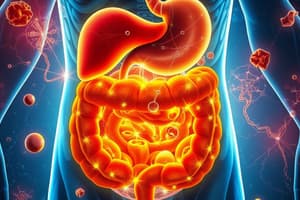Podcast
Questions and Answers
Which of the following is the least toxic form of nitrogenous waste excreted by animals?
Which of the following is the least toxic form of nitrogenous waste excreted by animals?
- Ammonia
- Carbon dioxide
- Uric acid (correct)
- Urea
Which of the following substances requires a large amount of water for its elimination?
Which of the following substances requires a large amount of water for its elimination?
- Urea
- Uric acid
- Carbon dioxide
- Ammonia (correct)
What is the process of excreting ammonia called?
What is the process of excreting ammonia called?
- Ammonotelism (correct)
- Ammonification
- Uricotelism
- Ureotelism
Which of the following is NOT a common nitrogenous waste excreted by animals?
Which of the following is NOT a common nitrogenous waste excreted by animals?
What is the main function of the human excretory system?
What is the main function of the human excretory system?
Flashcards
Uric acid
Uric acid
Uric acid is the least toxic form of nitrogenous waste excreted by animals. It is found in birds, reptiles, and insects. Compared to ammonia and urea, uric acid requires less water for excretion.
Ammonia
Ammonia
Ammonia is a highly toxic form of nitrogenous waste that requires a lot of water for excretion. It is found in aquatic animals like fish.
Ammonotelism
Ammonotelism
Ammonotelism is the process of excreting ammonia as the primary nitrogenous waste. This process is common in aquatic animals.
Carbon dioxide
Carbon dioxide
Signup and view all the flashcards
Human Excretory System
Human Excretory System
Signup and view all the flashcards




